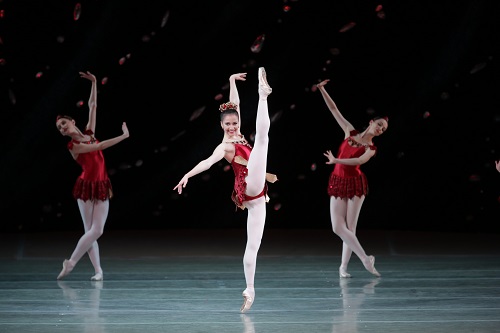 United States Fauré, Stravinsky, Tchaikovsky, George Balanchine’s Jewels: Artists of the Mariinsky Ballet and Orchestra / Alexei Repnikov (conductor), Dorothy Chandler Pavilion, Los Angeles, 26.10.2019. (JRo)
United States Fauré, Stravinsky, Tchaikovsky, George Balanchine’s Jewels: Artists of the Mariinsky Ballet and Orchestra / Alexei Repnikov (conductor), Dorothy Chandler Pavilion, Los Angeles, 26.10.2019. (JRo)

Renata Shakirova in ‘Rubies’. Photo by Natasha Razina © State Academic Mariinsky Theatre
Production:
Staging – Karin von Aroldingen, Sarah Leland, Elyse Borne & Sean Lavery
Sets – Peter Harvey
Costumes – Karinska
Recreations of costumes – Holly Hynes
Original Lighting – Ronald Bates
Lighting – Perry Silvey
Principal Cast:
‘Emeralds’: Yana Selina, Konstantin Zverev
‘Rubies’: Renata Shakirova, Kimin Kim, Yekaterina Chebykina
‘Diamonds’: Maria Khoreva, Timur Askerov
On the surface, Jewels, Balanchine’s plotless, three-act ballet, is about gemstones, but what makes this ballet endlessly fascinating is the choreographer’s presentation of three distinct styles of dance. Dig deep and the riches unfold. The music is precisely coordinated to each of the countries of origin: elegant France, urban America and imperial Russia; and the embodiment of these countries is displayed in each style of movement – poetic and lyrical in ‘Emeralds’, jazzy and mischievous in ‘Rubies’, regal and profound in ‘Diamonds’.
Because each part is so distinct, with three different composers providing the scores, the sections are sometimes staged independently. But to understand the artistry of Balanchine, the full-length performance is illuminating. The ballet builds with each successive part, and the cumulative effect is emotionally affecting. For me, it feels like a portrait of the artist – how, having lived and worked in all three countries, Balanchine’s creative genius was formed through the influences of time, place and culture.
Many companies worldwide have performed the ballet, but New York City Ballet is the gold standard. It’s no surprise that the dancers of the Mariinsky Ballet were at their best in the last section, ‘Diamonds’, which distills the splendor of every nineteenth-century Russian ballet into one abstract dance and honors the tradition of the Russian school.
The first section, ‘Emeralds’, set to music by Gabriel Fauré from Pelléas et Mélisande and Shylock, is imbued with a tender romanticism and quiet sophistication. The longer skirts of Romantic ballet refer to such early-nineteenth-century classics as La Sylphide and Giselle. The dancers, wearing shades of green punctuated by emeralds, presented a dazzling opening picture. Yana Selina, admirably partnered by Konstantin Zverev, was suited to Balanchine’s neoclassical style of dance, executing the footwork and port de bras with both control and expansiveness. The pas de trois by Alexandra Khiteeva, Anastasia Lukina and Victor Caixeta was charming.
‘Rubies’ is set to Stravinsky’s Capriccio for Piano and Orchestra. With irreverent Jazz-Age rhythms, the music propels the choreography. In Complete Stories of the Great Ballets, Balanchine protests the piece’s connection to America, claiming ‘It is simply Stravinsky’s music, which I have always liked’, but the effect is undeniable. It’s a catalogue of signature Balanchine style coupled with the zesty abandon of American youth. Backs sway, hips jut, legs jog and gallop and playfulness abounds. It was vigorously danced by Renata Shakirova partnered by Kimin Kim, and they managed all the intricacies of the rapid-fire footwork. Though infectiously joyful in her performance, there was too much drama in Shakirova’s hand movements, which I found distracting. Kim was a powerhouse, more impish than nuanced. Soloist Yekaterina Chebykina led the members of the corps who projected the vivacity of youth unfettered by tradition.
‘Diamonds’, set to Tchaikovsky’s Symphony No.3 in D major, was a moving finale. The Mariinsky was shown to great effect in this section, particularly in the final polonaise with thirty-four dancers. Though plotless, the choreography referred to the classic love story of princess and cavalier, enacted to perfection by Maria Khoreva, with a beautiful line to her neck and back, and Timur Askerov, every inch a danseur noble. The principals, soloists and corps were serenely comfortable with ‘Diamonds’, steeped as it is in the tradition of Russian Classicism seen through the lens of Balanchine’s vision.
The program was awash in the lyricism and verve of the Mariinsky Orchestra led by Alexei Repnikov, who handled with ease three very different scores. Aleksandra Zhilina gave an outstanding piano performance in the Stravinsky.
Jane Rosenberg